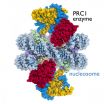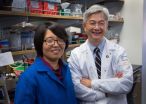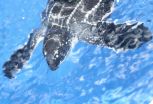First detailed picture of a cancer-related cell enzyme in action on a chromosome unit
2014-10-29
(Press-News.org) A landmark study to be published in the October 30, 2014 print edition of the journal Nature provides new insight into the function of an enzyme related to the BRCA1 breast-cancer protein. The study by a team at Penn State University is the first to produce a detailed working image of an enzyme in the Polycomb Repressive Complex 1 (PRC1) -- a group that regulates cell development and is associated with many types of cancer.
Enzymes like PRC1 turn on or turn off the activity of genes in a cell by manipulating individual chromosome units called nucleosomes. "The nucleosome is a key target of the enzymes that conduct genetic processes critical for life," said Song Tan, professor of biochemistry and molecular biology at Penn State University and the leader of the study's research team.
The Penn State scientists obtained the first crystal structure of a gene-regulation enzyme while it is working on a nucleosome. The image reveals previously unknown information about how the enzyme attaches to its nucleosome target. Before this study, scientists had been unable to picture exactly how cancer-related enzymes in the PRC1 group interacted with a nucleosome to control gene activity. The study is also the first to determine the crystal structure of a multisubunit protein complex bound to a nucleosome, which itself is a complex assembly of DNA and 4 histone proteins.
The research is the culmination of over 12 years of research by the Tan laboratory to capture an image of this important class of enzymes bound to the nucleosome. His lab earlier had determined the first structure of another nucleosome-bound protein, RCC1. "This is the second important structure from the Tan lab to date of a nucleosome in complex with a protein known to interact with and modify chromatin behavior, which in turn can influence human gene expression," said Peter Preusch, Ph.D., of the National Institutes of Health's National Institute of General Medical Sciences, which partially funded the research. "Along with Dr. Tan's previous work detailing a nucleosome bound to the key regulatory protein, RCC1, this new structure adds to our knowledge of how proteins can regulate the structure and function of our genetic material."
The research project was proposed and executed by team member Robert K. McGinty, a Damon Runyon postdoctoral fellow at Penn State. McGinty and Ryan C. Henrici, an undergraduate student in the Penn State Schreyer Honors College, grew crystals of the PRC1 enzyme bound to the nucleosome. The team then solved the three-dimensional structure of this large molecular assembly by X-ray crystallography. "We are excited about this crystal structure because it provides new paradigms for understanding how chromatin enzymes function," McGinty said.
The study performed in the Penn State Center for Eukaryotic Gene Regulation provides unexpected insight into the workings of the BRCA1 breast-cancer-associated tumor-suppressor protein. Like PRC1, BRCA1 is a chromatin enzyme that shares a similar activity on the nucleosome. Tan said, "Our study suggests that BRCA1 and PRC1 employ a similar mechanism to anchor to the nucleosome." Tan and his team now are working to visualize how BRCA1 and other disease-related chromatin enzymes interact with the nucleosome.
INFORMATION:
This research was supported by grants from the National Institutes of Health, the Damon Runyon Cancer Research Foundation, and Penn State University.
CONTACTS
Song Tan: sxt30@psu.edu, 814-865-3355
Barbara Kennedy (PIO): science@psu.edu, 814-863-4682
IMAGES
A high-resolution image is online at http://science.psu.edu/news-and-events/2014-news/Tan10-2014-2.
[Attachments] See images for this press release:


ELSE PRESS RELEASES FROM THIS DATE:
2014-10-29
NORTH GRAFTON, Mass. Developing resiliency has important benefits for children, especially those from military families faced with significant challenges such as parental deployment and frequent moves. New research published online in Applied Developmental Science supports the idea that, along with other key resources, strong attachments to animals may help military-connected children develop resiliency and other positive developmental traits.
"We were interested in seeing if the specific stressors faced by military-connected families could be mitigated by interacting ...
2014-10-29
UCLA research could lead to a simple saliva test capable of diagnosing — at an early stage — diabetes and cancer, and perhaps neurological disorders and autoimmune diseases.
The study, the most comprehensive analysis ever conducted of RNA molecules in human saliva, reveals that saliva contains many of the same disease-revealing molecules that are contained in blood. It was published online today by the peer-reviewed journal Clinical Chemistry and will be published in the journal's January 2015 special print issue, "Molecular Diagnostics: A Revolution in Progress."
"If ...
2014-10-29
MADISON, Wis. — Bigger is better, if you're a leatherback sea turtle.
For the first time, researchers at the University of Wisconsin-Madison, Florida Atlantic University (FAU), and the National Oceanic and Atmospheric Administration (NOAA) have measured the forces that act on a swimming animal and the energy the animal must expend to move through the water.
A surprising finding: Longer, slender turtles are less efficient swimmers than more rotund turtles, which get better stroke for their buck.
By taking these measurements, the research team — led by UW-Madison's ...
2014-10-29
Heparin, the life saving blood thinner used in major surgeries and treatment of heart diseases, is a complicated drug but a research team from the University of British Columbia has set out to make its use a lot safer by developing a universal antidote.
Heparin's blood thinning action often requires an antidote to reverse its effect before serious bleeding issues arise especially in the case of major surgical procedures.
Finding an approved drug to reverse the blood thinning effect of heparin is complicated because there are about a dozen approved heparin products ...
2014-10-29
Maggot infestations, rotting carcasses, unidentifiable gunk in the kitchen sink – how much your brain responds to disgusting images could predict whether you are liberal or conservative.
In a study to be published in an upcoming issue of Current Biology, an international team of scientists led by Virginia Tech reports that the strength of a person's reaction to repulsive images can forecast their political ideology.
"Disgusting images generate neural responses that are highly predictive of political orientation even when those neural responses don't correspond ...
2014-10-29
Sleep apnea may affect your ability to form new spatial memories, such as remembering where you parked your car, new research led by NYU Langone Medical Center sleep specialists suggests.
The study, published online Oct. 29 in Journal of Neuroscience, demonstrates through the playing of a specific video game that disruption of rapid eye movement (REM) sleep as a consequence of sleep apnea impairs spatial memory in humans even when other sleep stages are intact.
Spatial memory is utilized for everyday tasks, such as remembering the location of a favorite restaurant, ...
2014-10-29
Wind shear has kicked in and has been pushing clouds and showers away from Tropical Cyclone Nilofar's center. NASA's Aqua satellite captured an image that showed the effects of the shear on Oct. 29.
The Moderate Resolution Imaging Spectroradiometer aboard NASA's Aqua satellite captured an image of Tropical Cyclone Nilofar on Oct. 29 at 09:00 UTC (5 a.m. EDT). Tropical Cyclone Nilofar is moving through the Arabian Sea. The image shows that clouds were being pushed to the northeast of the center of the storm, from strong southwesterly wind shear.
On Oct. 29 at 1500 UTC ...
2014-10-29
In the largest study of its kind to date, researchers have used DNA sequencing to uncover dozens of genes that heighten the risk for autism. Joseph Buxbaum, Ph.D., Icahn School of Medicine at Mount Sinai, New York City, Mark Daly, Ph.D., Broad Institute of Harvard and MIT, and their colleagues examined more than 14,000 DNA samples from affected children, parents and unrelated people. They identified changes in 107 genes that are likely to contribute to the risk for autism spectrum disorder (ASD) – a jump from the nine genes implicated in earlier studies using these ...
2014-10-29
Small differences in as many as a thousand genes contribute to risk for autism, according to a study led by Mount Sinai researchers and the Autism Sequencing Consortium (ASC), and published today in the journal Nature.
The new study examined data on several types of rare, genetic differences in more than 14,000 DNA samples from parents, affected children, and unrelated individuals – by far the largest number to date – to dramatically expand the list of genes identified with autism spectrum disorder (ASD).
Most of the genes that contribute to autism remain ...
2014-10-29
A research group led by Anne Dutrey from the Laboratory of Astrophysics of Bordeaux, France, and the National Centre for Scientific Research (CNRS) observed the distribution of dust and gas in a binary star system called GG Tau-A. It was recently discovered that one of GG Tau-A's components is itself a double star. This object is only a few million years old and lies approximately 460 light-years from Earth in the constellation Taurus.
Like a wheel in a wheel, GG Tau-A contains a large, outer disk encircling the entire system as well as an inner disk around the main central ...
LAST 30 PRESS RELEASES:
[Press-News.org] First detailed picture of a cancer-related cell enzyme in action on a chromosome unit






